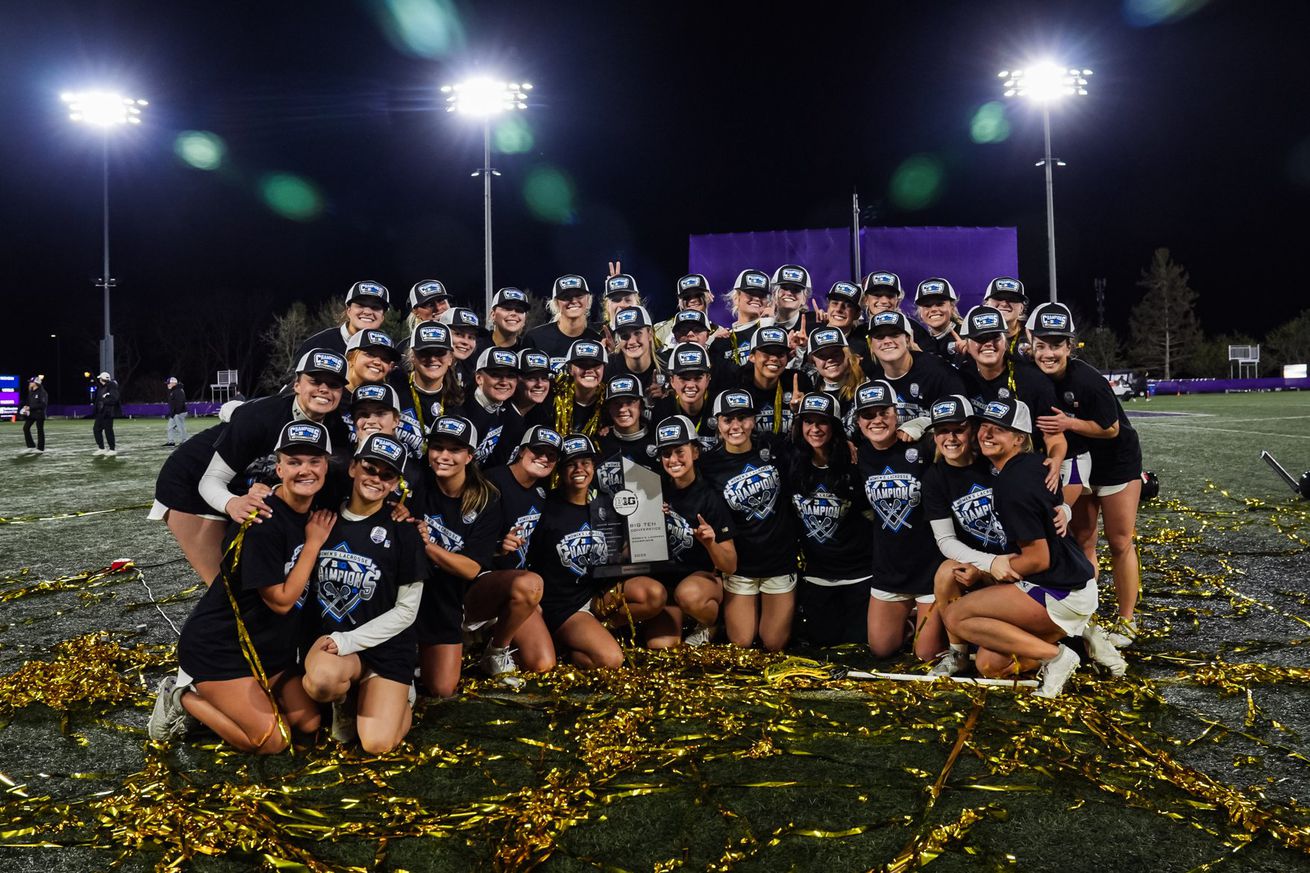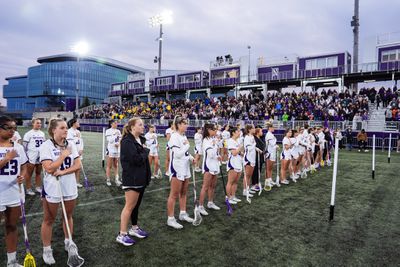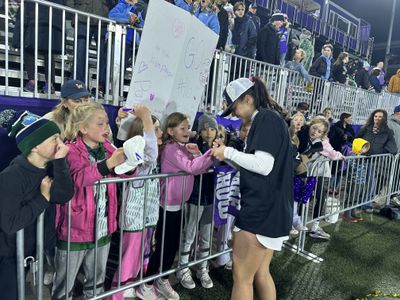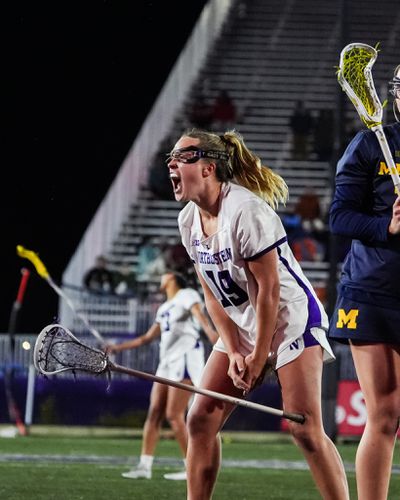
“Lacrosse Night in Chicago” showed that great lacrosse can be played anywhere, highlighting everything Northwestern represents.
The trophy-hoisting wasn’t new for Northwestern lacrosse. Nor were the confetti or the championship t-shirts. Claiming a fourth Big Ten regular season championship felt routine, given Northwestern’s titles in 2021, 2023 and 2024.
And yet, when the No. 3 Wildcats routed No. 13 Michigan 15-6 on Thursday night to stand atop their conference once more, it felt anything but ordinary. It was a 3,503-fan spectacle of flashing lights, relentless crowds and a shattered Northwestern attendance record at Northwestern Medicine Field at Martin Stadium.
“There was a moment, I don’t know if it was the second or third quarter, I just looked around and I’m like ‘Holy cow. This is women’s lacrosse.’” said Niki Miles, who contributed four goals against the Wolverines, postgame. “The fact that it’s growing so much is just really special, and something I couldn’t have even imagined — especially where I grew up in California, it wasn’t very big.”
Northwestern-Michigan, dubbed as “Lacrosse Night in Chicago”, showcased the rise of the women’s game in the Midwest — a region where Northwestern, as the only program located outside the Eastern Time Zone to win a national title, serves as somewhat of a Mecca.
The event was a vision struck up by Northwestern creative content director Jack Sullivan shortly after Martin Stadium’s expansion for the 2025 and 2026 football season, and it was heavily marketed across platforms ranging from a social media promo from Northwestern football coach David Braun to a Christine Brennan-narrated hype video.
But it’s not surprising that this team went above and beyond to ensure its regular-season home finale was beyond just a game.

Northwestern Athletics
Yes, Thursday night was a celebration of women’s lacrosse. But it also exemplified the character of a program that built itself off being the exception to the rule; one that formed its identity as a perennial underdog, breaking the boundaries of a once-insular sport exclusive to small Northeastern pockets of the United States.
This is a program currently led by a player like Madison Taylor, who scored six goals Thursday night, but was once overlooked amongst a swath of other Long Island talent coming out of high school. And by someone like Sammy White, who broke traditions by not suiting up for the Terrapins like the rest of her Baltimore counterparts, instead opting to play halfway across the country. And by Californian Emerson Bohlig and Coloradan Lucy Munro, who spent their childhoods traveling thousands of miles to the East Coast to display their full potential as recruits.
“We have built this program on taking chances on people from different areas, maybe different levels of experience to the game and just really developing them and building them,” Northwestern head coach Kelly Amonte Hiller told media on Monday. “The success of Northwestern, I think, gives hope to a lot of different programs that you don’t have to be from a certain area to have success. You can be from anywhere.”
During a time when women’s lacrosse is at a crossroads, Amonte Hiller’s message is all the more important. With the sport set to make its Olympic debut at the Los Angeles 2028 Games, geographic diversity is necessary for its increased viability. And Northwestern’s efforts, as it showed on Thursday and throughout its entire history, will help spearhead the charge.
Michelle Sebastian still remembers what it was like to face Northwestern athletes.
Sebastian, who played college lacrosse at Vanderbilt and is now the recruiting director at the Illinois-based Lakeshore Lacrosse club, participated in a Chicago-area women’s summer league during the early 2000s. There, she competed against Ashley and Courtney Koester, twins who would eventually be on Northwestern’s first national championship roster in 2005 despite never playing lacrosse before college.
The Koesters, who hailed from Indiana, both ended up All-Americans (preseason/postseason) by their senior year. What set them apart, even early on in their careers, was their sheer athleticism.
“They were just very impressive athletes who were really strong, really fast and had great not just front-to-backseat speed, but side-to-side speed,” Sebastian said.
Stories like the Koesters are a rarity now. But Northwestern’s recruiting mentality hasn’t changed — Amonte Hiller was the pioneer of seeking out pure athletes regardless of origin or experience, and she sticks to this still. Not only did her approach open the door to players with more untapped potential, but it also expanded NU’s reach beyond renowned club teams on the East Coast.
Amonte Hiller’s strategy is evident amongst the makeup of Northwestern’s greats. Tewaaraton finalist Selena Lasota (2015-19) caught the coaching staff’s eye because of her success playing box lacrosse in British Columbia. NCAA Division I goals leader Izzy Scane (2019-24) grew up doing gymnastics and didn’t start lacrosse until middle school. Taylor wasn’t a top-50 ranked recruit out of high school but played soccer, basketball and track alongside lacrosse. Tamara Bohlig, mother of Emerson, believes her daughter caught Amonte Hiller’s eye because of her speed.
More coaches are adopting Amonte Hiller’s strategy now, such as Southern Florida’s head coach Mindy McCord, who started the women’s lacrosse program at Jacksonville. McCord focuses on recruiting in the Southeast, another non-traditional lacrosse area, but she also pays attention to good athletes ignored by other programs because they don’t have “refined stick skills.” This recruiting method, originally ignited by Northwestern, stands as a counter to all the disadvantages that recruits from non-traditional areas face.
Greg Courter, Scane’s former high school coach, believes that his former players who reached the Division I level were overshadowed due to their Michigan roots. Although he devotes time to developing girls through his Monarch Lacrosse club, his top players — such as Scane and current Syracuse starting midfielder Mileena Cotter — played on club teams in the East Coast to better themselves. Courter doesn’t foresee a world where that changes in his lifetime.
“I tell the kids all the time, ‘Listen, we’re from Michigan. If you want to play in college…please understand that people have to work twice as hard and twice as long to make up for the amount of time and the level of competition that the average player gets on the East Coast,” Courter said. “It’s hard because we’re in a vacuum by not being exposed to all that competition at high-level play.”
“If I tried to put together one team of one class in the state of Michigan, I would be hard-pressed to pull together enough girls that could compete with any club from back East. We’re not there yet, and I don’t see that changing anytime soon.”

Yanyan Li
It’s not just a Michigan issue, as Northwestern’s Munro played for a club in Pennsylvania despite living in Colorado. Glen Miles, who witnessed his daughters Niki and Jordan get recruited in California and Baltimore respectively, noticed the significantly higher level of competition in the latter location.
States like Florida and Illinois are in better situations with more club options that make it easier for the state’s best players to stay at home. However, the disadvantages persist. Attending top-tier recruiting showcase camps can prove to be more costly and time-consuming for players not located in lacrosse hotbeds. The girls’ high school soccer and lacrosse seasons also overlap in Illinois, Michigan and Wisconsin, forcing players to choose between a newer sport and a more established one.
In addition, conventional attitudes are still present. The Bohlig family gets looks of bewilderment at tournaments when they say they hail from California. Adelaide Dieckmeyer, Serafina DeMunno’s old high school coach at St. Viator Prep in Illinois, said DeMunno was constantly emailing coaches to ensure they remembered her name. According to Sebastian, there remain “old-school” college coaches who put all Midwestern kids under an umbrella and assume that they aren’t good because of where they come from. Oftentimes, she has to convince those coaches to give her players a chance.
“Part of my job as a recruiter is to put in a phone call before someone goes to camp and say, ‘Hey, this kid is one of our top kids. She’s really good. You should put her in your top recruiting group,’” Sebastian said. “That part makes a difference for recruiting for us.”
Women’s lacrosse has grown tremendously since a few decades ago, where its presence in these non-traditional areas was almost non-existent. However, players from these areas still face barriers in their college search — a problem that Northwestern’s recruiting philosophy aims to combat.
“Growing lacrosse” is easier said than done. Because even with high-level programs in non-traditional areas like Northwestern succeeding, there exist several discrepancies on a grassroots level.
The Illinois High School Athletic Association did not sanction lacrosse until 2018. McCord says that several Tampa-area high schools do not have junior varsity teams, which she thinks are crucial for player development. Non-traditional areas lack resources, coaching and general interest in the sport to compete with the East Coast.
In addition, not all families can afford the travel and equipment costs of lacrosse, which are further perpetuated in areas where the sport isn’t as prevalent. McCord, who was a first-generation college student, spends time promoting lacrosse in low-income schools and wishes more teams would do the same.
“Like, we’ve been in Title One schools where 97% of all those kids at the school were on free lunches — they would never know of an opportunity down the road to play in college if we didn’t make a commitment to get in those schools.”
This discussion also translates to major events like the Final Four. The women’s edition of the event was held in the non-traditional area of Cary, North Carolina for the past two seasons and drew just over half the attendance it did when held in the lacrosse hotbed of Baltimore during 2022.
With Northwestern set to host the women’s Final Four in 2026, these issues need to be considered, hence why events like Lacrosse Night in Chicago serve as preparation for marketing significant tournaments in the area.
“If we were to just have the game in Philadelphia or in Baltimore, you would have people in the community saying, ‘we’ll take the family and go.’ And that’s just not going to happen in Georgia or North Carolina,” Sebastian said. “I think it’s important to have a media presence and let people know to come so that you get more people interested. You do get a bigger audience.”
Issues like these contribute to recruiting pitfalls that lacrosse players from non-traditional areas face, as well as the discrepancy within the cream of the crop.
Out of the 87 total finalists of the women’s Tewaaraton Award, annually given to the nation’s top Division I player, 75 hail from states part of the New England or Mid-Atlantic region. Another stat, however, is that five of the 12 “exceptions” are Wildcats. They include Christy Finch (Hudson, Ohio), Hannah Nielsen (Adelaide, Australia), Taylor Thornton (Dallas, Texas), Selena Lasota (Campbell River, British Columbia) and Izzy Scane (Clarkston, Michigan). Scane, alongside Boston College’s Charlotte North (Dallas, Texas), are the first two American Tewaaraton winners not from the East Coast. They also happen to be the leading goal scorers in Division I lacrosse and two of the most popular players in the sport.
Women’s Tewaaraton Award finalists by hometown (full version on MapHub.net):
Most of the award’s future finalists will probably be from the East Coast. However, every so often, someone could emerge from a new place, and as history has proven, they could likely be wearing purple and white.
And as history has proven with players like Scane and North, their differences could also make them rise above the rest. It shows that despite inequalities still existing across the board, a handful of trailblazers are still paving the way.
“I like to remind East Coast friends that think everything started with them, that [Scane and North] are from non-traditional areas, and there’s going to be more and more of those people,” Sebastian said.
“They march to the beat of their own drums. They’re going to be good how they’re going to be good, and they don’t have any rules above them, hampering them from trying new things and experimenting on the field.”
Even though women’s lacrosse still has a long way to go toward becoming a widely-played sport nationwide, the progress was evident in Martin Stadium on Thursday night.
It was shown through the litany of girls on local club teams scattered across the West side bleachers, looking at the players in front of them as examples of what they could become. It was shown through Scane, who was signing autographs in the stands. It was shown through the flurry of promotional videos, giveaway tents and “Lake Show” branding — all for a sport that could have easily been brushed off as “non-revenue.”

Northwestern Athletics
And most importantly, it was shown through Jane Hansen’s fast-break turnovers, Delaney Sweitzer’s saves in the cage, Sam Smith’s dominance in the draw circle, Taylor and Miles’ scoring onslaughts, Bohlig’s quickness in transition and everything else that contributed to Northwestern’s victory.
“I give Northwestern a lot of credit for the way they’ve marketed the women’s lacrosse program there,” Courter said. “It’s hard to get a ticket now, which is a great problem to have, but the Lake Show is the most exciting women’s college sport experience in the Midwest.”
As women’s lacrosse looks onward to future Final Fours in Evanston and elsewhere, as well a historic Olympic cycle coming, a lot of work has to be done in terms of improving accessibility for all. This requires efforts not just at the United States’ top collegiate programs, but all across the country at all levels.
But make no mistake — Lacrosse Night in Chicago and everything it stood for proved that Northwestern was all-in on doing its part.
“We just got excited about it, like little kids in a candy shop in our office, thinking about what could be when we saw the football stadium and the environment that they were able to create here,” Amonte Hiller said. “We were like, ‘we can do this for lacrosse.’ And there was a lot of work that went into this from a lot of people. “
“And I’m just really grateful that people believe in women’s sports and people believe in Northwestern lacrosse and showed up for us. And I really hope this is just the beginning and we keep continuing to build off of this.”